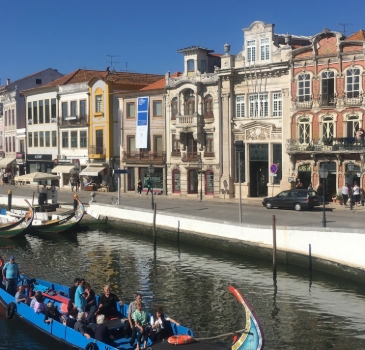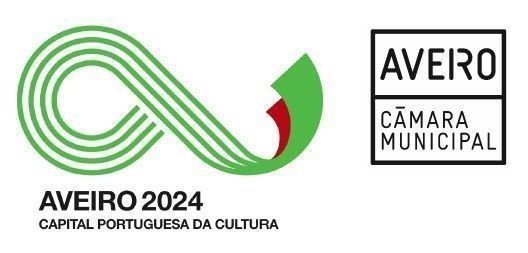Two hours by train from Lisbon and 40 minutes from Porto in an Alfa Pendular is Aveiro, the city of moliceiros and ovos moles. This coastal town was one of the four Portuguese cities that competed to win the title of European Capital of Culture in 2027, but the winner was Évora.
After the verdict was issued, and with the aim of taking advantage of the other three candidacies, the Portuguese Government decided to reactivate the Portuguese Capitals of Culture until then, naming one of the three remaining cities each year until 2027. The first to receive this recognition was Aveiro, followed by Braga in 2025 and Ponta Delgada in 2026. We mention the choice of Aveiro in an article last december.
Effect of being selected as “City of Culture in Portugal 2024” on tourism and private tours
In 2024, Aveiro is set to showcase its rich cultural and historical tapestry, offering an unforgettable experience that goes far beyond the surface. So far, we cannot say for certain if cultural tourism in Aveiro has significantly increased during this special year. Based on traffic to our private tours website, we’ve maintained our position as a top source of information, often directing visitors to official government sites. However, we haven’t seen a noticeable rise in private tour bookings. This could be due to the growing trend of large group tourism, while we specialize in smaller, more personalized tours focused on deep historical and artistic experiences, as well as organizing workshops.
Although we haven’t yet benefited from the events of this year, which seemed to appeal more to locals, some foreign residents with second homes in the area, or visitors from nearby Spain, we remain optimistic. We hope that through the quality of our content and the unique experiences we offer, we’re building a strong reputation for our private tours and promoting the city in a meaningful way that will pay off in the future.
We added Aveiro in the short list of “The six art nouveau hidden gems in Europe”. This was a well deserved distinction for a top destination.
Aveiro is much more than its postcard-perfect scenery
Known as the “Venice of Portugal,” this coastal gem captivates visitors with its Art Nouveau heritage and stunning natural beauty. With its Atlantic-facing landscapes, picturesque canals, and unique houses, Aveiro stands as one of Portugal’s most charismatic cities. In 2024, it has gained further recognition as the first Portuguese Capital of Culture, hosting events throughout the year.
A stroll along its famous canals only scratches the surface. The city’s architectural wonders take center stage, boasting the largest concentration of Art Nouveau buildings in Portugal. Among the highlights is the City of Aveiro Museum, an iconic example of this elegant style. Republic Square, located in front of the Town Hall and Clock Tower, showcases Aveiro’s charm and is an ideal starting point for exploring its richly tiled churches—like Misericordia—and the vibrant Coimbra Street, which leads to the stunning Baroque altarpiece in the cathedral.
Beyond its urban allure, Aveiro’s port and fishing traditions come to life through striking industrial architecture. Notable landmarks include the Mercado do Peixe, designed by none other than Gustave Eiffel, and the Jerónimo Pereira factory, now transformed into a congress center. The city’s natural surroundings are just as fascinating, with the colorful houses of Costa Nova, the salt flats, and Portugal’s tallest lighthouse—straight out of a Wes Anderson movie—all beckoning for exploration.
The Cradle of Portuguese art nouveau
Walking through this picturesque city of canals, one’s gaze inevitably turns to the occasional flashes of colour that appear between contemporary buildings. This architectural spectacle is part of the legacy left by the art nouveau period in Aveiro.
Originating in Belgium at the end of the 19th century, this artistic movement quickly spread across Europe, taking on a different identity in each country. The arrival of art nouveau in Portugal coincided with its end in the rest of the continent. It was sometime between 1907 and 1909 that the first buildings in this architectural style began to appear in the city, although the first example was erected in the house of the architect who brought it to Portugal, Francisco Silva Rocha, from Aveiro. Hence, the city soon became the art nouveau capital of the country.
The arrival of this architectural style coincided with a period of renaissance that followed the opening of the Barra de Aveiro a few decades earlier. The exuberance and permanent celebration of colours of Art Nouveau were synchronised with Aveiro’s desire for urban affirmation. Thus, Art Nouveau became a symbol of this prosperity and, therefore, of a new Aveiro.
The most emblematic example is the Casa Major Pessoa, the city’s ex-libris, with its mix of lace stone and powerful wrought iron, which is why it was converted into the Art Nouveau Museum in 2008. Other buildings that stand out in Aveiro’s urban landscape are the Farmácia Ala, the Casa das Quatro Estações and the Vila Africana.
The Venice of Portugal
It is a cliché, but it is an unavoidable cliché: Aveiro has been nicknamed the “Portuguese Venice” for the canals that cross the riverside area and that are part of the complex engineering game that controls the wild temperament of the city’s estuary. Over time, these waterways have ceased to be a mere utility, to become an indisputable part of Aveiro’s identity, along with the boats that cross them, the colorful moliceiros with which you can discover all the corners of the city.
The various canals that meander along the estuary were created not only to control the rise of the waters, but also to navigate them, transporting the products manufactured in the Aveiro lagoon (such as salt), which arrived at the Port of Aveiro and headed for the city. These came from the docks located in the estuary or from the small islets scattered along it. Check our exclusive 4-hour private tour to discover this city.
There are three main canals within the city: the Canal do Cojo, the Canal Central and the Canal de São Roque. The first two run through the centre, with the old Captaincy of the Port of Aveiro as their axis, while the third runs along and connects with the estuary. The use of the canals in the city’s economy is evident even in its place names: the Canal do Cojo, for example, was once called Ribeira das Azenhas, due to the concentration of these mills on its banks; and the area of the Canal de São Roque has always been called Bairro à Beira-Mar because it was the point where many of Aveiro’s salt mines were located, also due to its favourable geographical location. For more information on itineraries, CLICK HERE.
In Porto, art nouveau is also present, check the Porto website to find out more.
orto stands as a key player in Portugal’s Art Nouveau narrative, boasting an impressive collection of architectural masterpieces that encapsulate the elegance and creativity of the era. As you wander through its streets, you’ll encounter buildings that not only showcase stunning artistry but also reflect the city’s historical significance. Discover more about Porto’s offerings by visiting Visit Porto. To enrich your visit, artnouveau.club is here to help organize exclusive private events and tailored experiences that immerse you in the beauty and history of Porto’s Art Nouveau scene.
Some nice pics from Aveiro:












